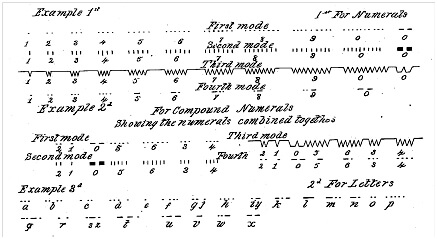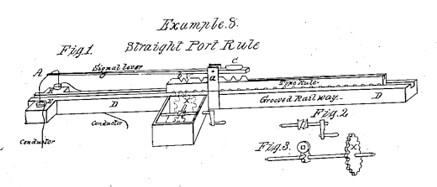With the advent of new communications technology and with the launch of new smartphones almost every day in the market, telephone now seems an old world charm. Similarly, there have been many ground breaking inventions which have laid foundations for the present communications technology.
It is interesting to note that many inventions, not particularly in communications technology, have defined the Industrial Revolution and some have even changed or redefined the course of “World Wars”. Hundreds of posts are available listing such inventions. But, here in this post, the listing would be of “Patented Inventions” and their effect. Immediate question is where to start. Let’s begin with “this-day-that-year” rule.
On June 20, 1840, Samuel Morse was granted a patent for electro-magnetic telegraph in US. Morse further improved his invention and got two reissue patents on January 15, 1846, and June 13, 1848.
Prior to him, Sir William Fothergill Cooke and Charles Wheatstone had patented the first commercial electrical telegraph on December 12, 1837 in UK. Similarly, Edward Davy had also been granted a patent for electrical telegraph on July 4, 1838, that was later purchased by the Electric Telegraph Company, created by Sir William Fothergill Cooke. These prior patents did not prevent grant of patent in US, though Morse did not get a patent in Europe.
Cooke and Wheatstone’s telegraph used five magnetic needles that could be pointed around a panel of letters and numbers by using an electric current. On the other hand, Morse’s telegraph was a single-circuit apparatus that worked by pushing down a key to complete an electric circuit of battery. The messages would be sent as Morse code, set of dots (short marks) and dashes (long marks) for representing alphabets and numbers based on their frequency of usage. The message would then be rendered by receivers connected with the telegraph using wires. Relays or repeaters were used between the transmitter and the receiver. By 1851, Morse’s telegraph became official standard for European telegraph except in UK.
Below are the figures from Morse’s Patent:
- Morse Code examples

- Morse Apparatus example

- Cooke and Wheatstone’s telegraph

The telegraph and Morse code changed the way information was being communicated which resulted in changing everything – from fighting wars to sending personal messages to conducting news business.
It is interesting to note that Morse’s telegraph was also embroiled in litigation case which laid the foundation for the US Patent Law governing the eligibility of computer program implemented inventions and inventions implementing natural laws. The case is famously known as Telegraph Patent Case or as O’Reilly v. Morse and was finally decided by US Supreme Court (SC).
Briefly, Morse sued Henry O’Reilly & others (defendants) for infringing his patent. In defence, defendants took the following grounds, inter alia, (i) Morse was not the true and original inventor of this telegraph; & (ii) telegraph constructed and employed by the defendants is substantially different from the telegraph described in the Morse’s patent. After a lengthy investigation, the SC ruled against both grounds. For ground (i), the SC stated that Morse had been the first to combine the battery, electromagnetism, the electromagnet and the correct battery configuration into a workable practical telegraph. Such mechanism was different from the patents granted to Cooke and Wheatstone in 1837 and Davy in 1838. For ground (ii), the SC compared the construction of machinery and operation of the machinery specified in the Morse’s patent and telegraph being constructed and operated by the defendants, and found that the defendant’s machinery and working is substantially same as described in Morse’s patent.
Despite this strong ruling, the SC only allowed 8 out of 9 claims. SC did not allow claim 8 which claimed a method of communicating intelligible information to any distance by means of exploiting the electro-magnetic force. The SC stated that this claim was too broad as Morse’s patent claimed that Morse discovered electric or galvanic current will always print at a distance, no matter what may be the form of the machinery or mechanical contrivances through which it passes. This would mean that any type of technology could be used for communicating information over long distances using electromagnetism. However, SC noted that the specification did not describe any other ways or apparatus apart from the specific apparatus as claimed in the Morse’s patent.
In addition, the SC also used “apparatus limitation” to determine whether the claim [8] was at such a high level of generality and abstraction that it claimed an “idea” rather than a practical application and implementation of an idea. In this regard, the SC looked to a recent English decision “Neilson v. Harford”. In Neilson, the Court of Exchequer Chamber upheld a patent on using heated air to oxidize carbon in cast iron in a Bessemer Converter against the claim that it was just a patent on the idea or principle that heating the injected air makes a blast furnace work better. The SC pointed to the fact that patent is granted to an “apparatus used to preheat the air”, thereby making the patent “an implementation of the principle” rather than patent “for the principle itself”. In view of this, SC stated that Morse’s patent only disclosed a specific apparatus for transmitting signals at any distance by means of repeaters and by using electromagnetism. The lack of such apparatus in claim 8 not only discourages others to provide different/better ways of sending signals but also patents an abstract idea rather than an implementation of the abstract idea.
Even though now the telegraph has been made extinct by many new communication technologies, it is worth noting the effect the telegraph had in shaping the modern day communications and the patent laws.
http://inventors.about.com/od/todayinhistory/a/june.htm
http://inventors.about.com/od/indrevolution/a/telegraph.htm
http://www.history.com/topics/inventions/telegraph
https://en.wikipedia.org/?title=Electrical_telegraph
https://en.wikipedia.org/wiki/Samuel_Morse
http://www.google.com/patents/US1647?dq=1647
https://en.wikipedia.org/wiki/O%27Reilly_v._Morse#cite_note-1
https://supreme.justia.com/cases/federal/us/56/62/case.html
https://en.wikipedia.org/wiki/Edward_Davy
http://www.asap.unimelb.edu.au/bsparcs/other/iee_davy.htm
Photo Source:
- Google Patent
- http://www.alamy.com/stock-photo-diagram-of-cooke-and-wheatstones-five-needle-telegraph-patented-1837-57309816.html



